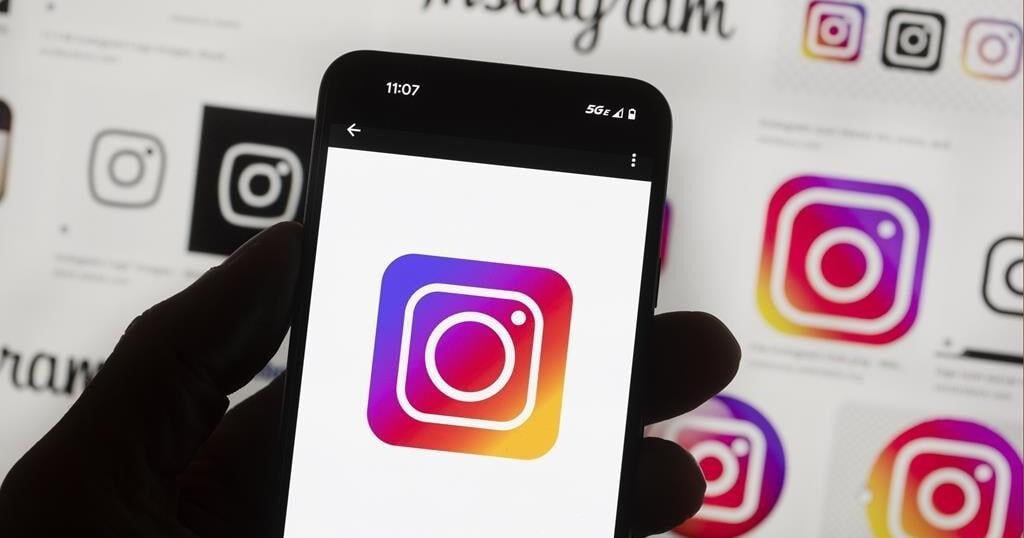TORONTO – Amid mounting accusations that kids aren’t being kept safe on social media, Instagram says it will automatically give teens private accounts with limited capabilities as their default.
The accounts launched for new underage users in Canada on Tuesday and will be handed to teens already on the platform over the next 60 days.
The account’s default settings include blocking teens from being messaged by people they aren’t connected with and minimizing their exposure to sensitive content such as posts that depict violence or encourage cosmetic procedures.
Parental supervision tools baked into the accounts will allow parents to see who their teen is messaging, when and how long they’re on Instagram, and set screen time limits. Those under the age of 16 will only be able to change the settings with parental approval.
The settings are Instagram parent company Meta Platforms Inc.‘s answer to a barrage of concerns parents, politicians and educators have raised about how much time teens are spending on social media platforms and what harms they’re encountering online.
The dangers prompted several provinces to ban phone use in class this school year and a handful of Ontario boards to sue Meta, TikTok and Snap for billions over accusations that the companies negligently design their products for compulsive use and rewire the way children think, behave and learn.
More than 30 states are perusing a similar case in the U.S., where former Meta staff previously told legislators that it’s common for youths on the platform to receive unwanted sexual advances or report having suicidal thoughts that became more frequent after signing up for Instagram.
A cascade of studies has also linked time online to lower self-esteem and academic performance as well as more exposure to hateful, violent and mature content.
Antigone Davis, vice-president and global head of safety at Meta, positioned Instagram’s new teen accounts as a product of feedback from parents who were finding it harder to guide and oversee their children’s online safety.
“Certainly, when I was a teen, my parents could get a lot from hearing my side of a phone conversation. They could get a lot by seeing who it was that I was interacting with and which friends I hadn’t had over in a while,” she said.
“But with so much happening online, parents have lost some of that visibility and it makes it harder for them to have conversations about what’s happening in their teens’ lives. This really opens up an opportunity for them to … have that kind of visibility and those insights to have those important conversations.”
Instagram has dabbled with restrictions for teens before, offering parents the ability to set time limits and schedule breaks for their kids, but speaking in London last week, Meta’s global affairs chief Nick Clegg said, “even when we build these controls, parents don’t use them.”
Users who are 17 and 18 will be able to turn off the restrictions that come with teen accounts without a parent’s permission.
The company is offering such leeway because it mirrors the additional freedom and independence kids are given as they grow up, Davis said.
And for anyone who thinks kids can easily escape restrictions by changing the birthdate they supply the platform with, she said Instagram will be able to catch if the user is lying about their age.
“If we see a teen who has an account once we make this announcement try to set up an additional account and register as an adult, we’re going to ask them to verify their age,” she said.
“If we see a teen try to change their age to an adult age within their existing account, we’re going to ask them to verify their age.”
The age verification can include teens handing over ID but also makes use of Yoti, a company relying on facial analysis to determine one’s age.
Technology that Instagram is using will also alert the company to instances when teens report that they’re a certain age but then receive birthday wishes or post about being another age, Davis said.
Rival platform TikTok uses similar tools to detect teens and give them one-hour screen time limits that can only be bypassed with a code from their parents. The platform also offers family pairing, which allows parents to link their accounts directly with their teens’ and ensure their kids’ TikTok settings are agreed upon as a family.
Over at Snap, parental controls are also available along with tools that can keep teens from being contacted by anyone other than friends or people who already have their phone number and location-sharing is turned off by default.
This report by The Canadian Press was first published Sept. 17, 2024.


























